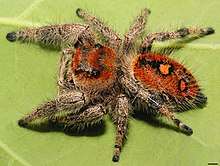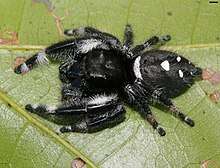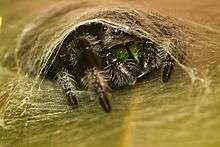Phidippus regius
Phidippus regius, known commonly as the regal jumping spider, is a species of jumping spider in eastern North America. Adult males range from 6 to 18 mm (0.24–0.71 in) in body length and average 12 mm (0.47 in). Females range from 7 to 22 mm (0.28–0.87 in) and average 15 mm (0.59 in). P. octopunctatus from western North America reaches a larger size.
| Phidippus regius | |
|---|---|
 | |
| Female | |
 | |
| Male | |
| Scientific classification | |
| Kingdom: | Animalia |
| Phylum: | Arthropoda |
| Subphylum: | Chelicerata |
| Class: | Arachnida |
| Order: | Araneae |
| Infraorder: | Araneomorphae |
| Family: | Salticidae |
| Genus: | Phidippus |
| Species: | P. regius |
| Binomial name | |
| Phidippus regius C.L.Koch, 1846 | |
| Synonyms | |
| |
Males and females are easily differentiated. The males are always black with a pattern of white spots and stripes. Females often bear similar patterns to the males, but range in color from shades of gray to a vivid orange.
The regal jumping spider belongs to the genus Phidippus, a group of jumping spiders easily identified both by their relatively large size and their iridescent chelicerae. Among most members of Phidippus, these chelicerae are generally green, but in the case of P. regius they are often a blue-violet.
Habitat

P. regius is most commonly found in relatively open areas, such as fields and light woodland, with adults usually preferring trees or the walls of buildings as hunting grounds. They build silken nests at night in which to sleep, often in palm fronds or similar areas. Females of the species lay their eggs under the bark of trees, or in secluded spots in wooden structures such as barns.[1]
Distribution
P. regius occurs in the southeastern United States and the West Indies, and has been introduced to Easter Island. It is most common on the Florida peninsula.
References
- Mari Mutt, José A.; Almodóvar Rivera, José R. "Animales y plantas con historias" (PDF). Ediciones Digitales (in Spanish). University of Mayaguez. p. 7.
External links
- regal jumping spider on the UF / IFAS Featured Creatures Web site
- Photographs of P. regius
- Diagnostic drawings